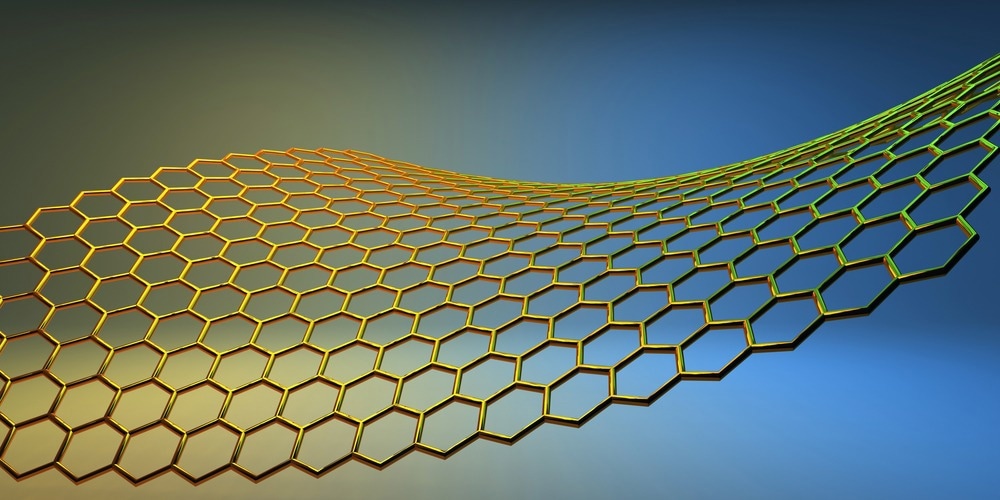Since the discovery of graphene in 2004, the world’s first ‘modern’ 2D material, hundreds of others have been isolated, each with a wide range of useful and interesting properties.
The boom in 2D materials has been driven by the potential they hold due to their range of properties, which are unique to their bulk form counterparts. These properties are being leveraged into novel applications previously impossible without the discovery of 2D materials.
Here, we will delve into the application areas that have emerged in the decades that have passed since 2004, highlight current hot topics in the field, look at the state of the global market, and consider where it is heading in the future.

Image Credit: Shilova Ekaterina/Shutterstock.com
Application Areas of 2D Materials
The application areas of 2D materials are vast. The unique properties of 2D materials have been leveraged in the biomedical sector, composites and coatings, electronics, energy, membranes, sensors, healthcare, wearable technology, and more.
Graphene is one of the most established 2D materials, having been isolated first. It is incredibly lightweight and strong, transparent, and is an excellent conductor of both heat and electricity.
Already, graphene’s unique properties have been leveraged into a number of applications. In particular, graphene has made great waves in the biomedical sector, as its extreme thinness and the relative ease of modifying its surface property (e.g. hydrophobicity to hydrophilicity) gives it enormous potential as a platform for drug development as well as a material for new biosensors.
For example, in a 2021 paper published in the Journal of Neural Engineering, researchers from the University of Technology, Sydney, described their novel biosensor, constructed from epitaxial graphene (EG) grown on a silicon carbide (SiC)-on-silicon substrate, that overcome the limitations of regular graphene biosensors (e.g. low durability, corrosion upon contact with sweat, high skin-contact impedance that distorts the detection of brain signals).
2D materials are revolutionizing many fields by making applications possible that were previously only theoretical, such as quantum computing, which relies on a variety of 2D materials, including graphene and hexagonal boron nitride, to build the superconducting qubits.
Medicine is taking the most advantage of these new materials and investing the most in research and development of 2D materials in applications from implants and wearables to drugs. For example, molybdenum disulfide is currently under intense investigation as a material for next-generation wearable technology.
A 2020 publication in the journal Nature Electronics has demonstrated how molybdenum disulfide can be used to produce sensitive and highly flexible wearables that have the potential to be leveraged in prosthetics and health monitoring technologies.
Hot Topics in 2D Materials
The full potential of 2D materials is yet to be realized, and as research in this field intensifies, we will likely see many more materials discovered, isolated, and leveraged into novel applications.
Graphene, for example, is used to prevent illness and disease in several ways. Graphene Flagship researchers at the Institute of Photonic Sciences, Spain, have developed a UV-Detection patch. The graphene wearable technology is flexible, transparent, and applied directly to the skin to detect and monitor exposure to UV rays. The prototype will be able to alert the wearer when they have reached their pre-defined threshold of UV exposure. The novel wearable will help prevent a range of health conditions, including sunburn and melanoma.
Another currently developing wearable is a graphene-based patch capable of monitoring blood glucose levels. The innovation will help people with diabetes access accurate readings of their blood glucose levels without the discomfort of daily blood tests. The wearable will also allow personalized insulin doses to be administered through the skin.
Graphene is also making an impact in the fight against food waste. As populations grow and crops are increasingly jeopardized due to the effects of global warming, experts warn of the lingering food crisis. Over recent years, methods of limiting food waste as a strategy for addressing food insecurity have become increasingly popular.
Recently, scientists developed a prototype of a revolutionary smart food packaging made from graphene that can detect atmospheric changes caused by food decay. The novel packaging will not only reduce food waste but also prevent illness.

Image Credit: Goncharov_Artem/Shutterstock.com
Finally, developments with the 2D material silicene are at the forefront of 2D material research. Silicene has garnered much attention in recent years, with scientists exploring the potential applications of its multifaceted properties, including excellent optical and electrical properties, high specific surface area, and desirable biocompatibility and biodegradability. Groundbreaking applications in the field of biomedicine are expected in the coming years from research and development with silicene.
Current Global Market of 2D Materials
The global market of 2D materials is expected to experience rapid growth between 2020 and 2027, growing at a CAGR of 3.9% in the forecast period to reach a valuation of $2.86 billion, up from 2020’s valuation of $2.27 billion.
Applications with graphene currently account for the largest share of the market; however, by 2027, it is predicted that silicene applications will overtake graphene to generate the largest share of market revenue. Borophene will also experience rapid growth. Graphyne, germanene, and stanene are notable 2D materials influencing the current market.
North America is currently the dominating region, holding more than half of the market share, followed by Europe, Asia Pacific, the Middle East and Africa, and South America. Over the forecast period, China will show rapid growth, driving the market in Asia Pacific. This region may gain a considerable part of the market share by the end of the decade. Extensive research and design and technological advances in applications such as graphene-based solar PV modules are propelling this growth.
Key players include 2-DTech, Layer One, ACS Material LLC, 2D Water, Dimpora, Titan Projects, Xlynx Materials, Thomas-Swan, Avanzare Innovation, Tecnologia SL, XG Sciences Inc., Blackleaf SAS, Nordic Graphite, Planar Tech, Armor, Nitronix, and others.
Future Directions for 2D Materials
There is much activity in the 2D materials market, and this activity looks set to accelerate in the coming years. The market will likely be driven by demand as well as what is learned from research into new 2D materials.
Currently, scientists in many sectors are exploring how the unique properties of the current 2D materials (e.g. excellent electrical and thermal conductivity, high optical and UV adsorption, good mechanical flexibility, and large surface areas) can be leveraged. In the next few years, we will likely see more innovations emerge in the fields of biomedical, composites and coatings, electronics, energy, membranes, sensors, healthcare, and wearables.
As more is discovered about 2D materials, and as more materials are discovered and isolated, it is likely that applications of 2D materials will widen even further.
Final Thoughts
The 2D material market is currently in an exciting period. Its full potential is yet to be realized and a number of innovations are expected to emerge from face-paced research and development in the coming years.
Materials such as graphene and silicine will likely be at the core of the majority of new developments; however, other materials such as borophene,graphyne, germanene, stanene, hexagonal boron nitride and molybdenum disulphide will also be important.
Finally, we might see the most growth in the sector directed toward developing healthcare solutions, with implants, wearables and novel therapeutics predicted to emerge as a result of research and development in this field.
References and Further Reading
2D Materials Market: Global Market Forecast and Future Potential [online]. Maximize Market Research. Available at: https://www.maximizemarketresearch.com/market-report/global-2d-materials-market/74941/
Li, N., Wang, Q., Shen, C. et al. 2020. Large-scale flexible and transparent electronics based on monolayer molybdenum disulfide field-effect transistors. Nat Electron 3, 711–717. https://doi.org/10.1038/s41928-020-00475-8
Panigrahi, P., Pal, Y., Hussain, T. and Ahuja, R., 2021. Application of germanene monolayers as efficient anchoring material to immobilize lithium polysulfides in Li-S batteries. Applied Surface Science, 558, p.149850. https://www.sciencedirect.com/science/article/abs/pii/S0169433221009260
Rossa, V., Monteiro Ferreira, L., da Costa Vasconcelos, S., Tai Shimabukuro, E., Gomes da Costa Madriaga, V., Carvalho, A., Castellã Pergher, S., de Carvalho da Silva, F., Ferreira, V., Conte Junior, C. and de Melo Lima, T., 2022. Nanocomposites based on the graphene family for food packaging: historical perspective, preparation methods, and properties. RSC Advances, 12(22), pp.14084-14111. https://www.ncbi.nlm.nih.gov/pmc/articles/PMC9094098/
Shaikh Nayeem Faisal et al. 2021 J. Neural Eng. 18;066035. https://iopscience.iop.org/article/10.1088/1741-2552/ac4085
You, Y., Yang, C., Zhang, X., Lin, H. and Shi, J., 2021. Emerging two-dimensional silicene nanosheets for biomedical applications. Materials Today Nano, 16, p.100132. https://www.sciencedirect.com/science/article/pii/S2588842021000249
Zou, X., Xu, Y. and Duan, W., 2021. 2D materials: Rising star for future applications. The Innovation, 2(2), p.100115. https://www.ncbi.nlm.nih.gov/pmc/articles/PMC8454666/
Disclaimer: The views expressed here are those of the author expressed in their private capacity and do not necessarily represent the views of AZoM.com Limited T/A AZoNetwork the owner and operator of this website. This disclaimer forms part of the Terms and conditions of use of this website.